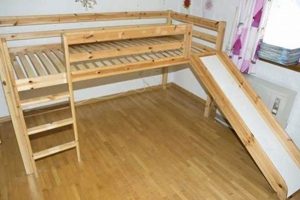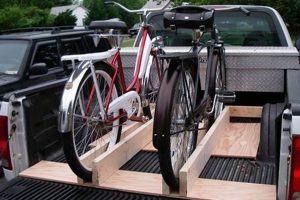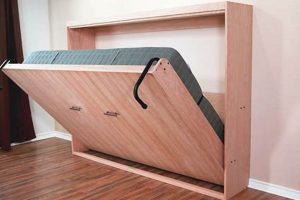Constructing a bicycle carrier for a pickup’s cargo area involves creating a structure to secure bicycles during transport. This typically involves utilizing readily available materials and tools to fashion a frame or mounting system that prevents movement and potential damage to the bicycles or the vehicle. For example, individuals might use lumber, metal piping, or repurposed materials to build a rack that fits within the truck bed and secures bikes by their frames or wheels.
Securing bicycles in this manner offers several advantages. It allows for safe and convenient transportation of bikes to various locations, such as trailheads or races, without requiring a trailer or rooftop carrier. The creation of a customized system often provides a cost-effective alternative to purchasing commercially available racks. Historically, individuals have often sought such solutions to address specific needs or budget constraints, demonstrating resourcefulness and problem-solving skills.
The subsequent sections will explore various design considerations, material choices, and construction techniques for building such a carrier, providing guidance for individuals looking to implement a customized solution for transporting their bicycles in a pickup truck.
Essential Considerations for Truck Bed Bicycle Carrier Construction
The following considerations are crucial for successful bicycle carrier construction within a pickup truck bed, ensuring both the safety of the bicycles and the integrity of the vehicle.
Tip 1: Material Selection: Prioritize durable materials resistant to weather and stress. Treated lumber, steel, or aluminum are viable options. Consider weight constraints and potential corrosion when making selections.
Tip 2: Secure Mounting Points: Utilize existing truck bed anchor points or create reinforced attachment points to prevent shifting during transit. Proper anchoring is paramount for stability and safety.
Tip 3: Bicycle Frame Protection: Implement padding or protective materials at all contact points between the rack and bicycle frames. This minimizes the risk of scratches and abrasion during transport.
Tip 4: Wheel Stabilization: Incorporate wheel cradles or restraints to prevent lateral movement of bicycle wheels. This enhances stability and reduces the likelihood of damage to wheel components.
Tip 5: Height Considerations: Account for the overall height of the bicycles when mounted. Ensure adequate clearance for bridges, tunnels, and overhanging structures to prevent collisions.
Tip 6: Weight Distribution: Distribute the weight of the bicycles evenly across the truck bed. Avoid concentrating weight in a single area, which can affect vehicle handling and stability.
Tip 7: Security Measures: Consider incorporating locking mechanisms or cable locks to deter theft. Secure bicycles to the rack and the rack to the truck bed to enhance security.
Adherence to these guidelines will contribute to the creation of a safe, reliable, and effective bicycle carrier for a pickup truck bed, mitigating risks and ensuring the secure transportation of bicycles.
The subsequent section will present a range of design concepts for such carriers, offering diverse approaches to address varying needs and preferences.
1. Material Durability
The longevity and operational safety of a self-constructed bicycle carrier for a pickup truck bed are directly contingent upon the durability of the materials employed in its fabrication. The selection of materials resistant to environmental degradation, physical stress, and fatigue is not merely a cosmetic consideration; it is a fundamental determinant of the rack’s structural integrity and ability to perform its intended function. A rack constructed from substandard materials will be susceptible to premature failure, potentially resulting in damage to the bicycles being transported or, more critically, posing a safety hazard to other vehicles and occupants on the roadway. Consider, for example, a wooden rack constructed from untreated lumber. Exposure to moisture and sunlight will lead to warping, rot, and eventual structural compromise, rendering the rack unsafe for use. Similarly, a metal rack fabricated from thin-gauge steel will be prone to bending or fracturing under the weight and dynamic forces exerted during transit.
The implementation of durable materials, conversely, offers demonstrable benefits. A rack constructed from pressure-treated lumber, steel with a rust-resistant coating, or aluminum alloy will exhibit a significantly extended lifespan and maintain its structural integrity under demanding conditions. Furthermore, the use of high-quality fasteners and connectors contributes to the overall durability of the structure. Regular inspection and maintenance, including the application of protective coatings and the replacement of worn components, are essential for maximizing the service life of the bicycle carrier. This proactive approach mitigates the risk of unexpected failures and ensures continued safe operation.
In conclusion, material durability is not simply a desirable attribute but an indispensable requirement for a functional and safe bicycle carrier within a pickup truck bed. Neglecting this consideration compromises the rack’s longevity and introduces significant safety risks. Diligent material selection, combined with consistent maintenance practices, represents a responsible approach to ensuring the reliable transportation of bicycles and mitigating potential hazards.
2. Secure Attachment
The secure attachment of a self-made bicycle carrier to the truck bed is paramount to the functionality and safety of such a system. The method of attachment directly impacts the carrier’s ability to withstand forces generated during vehicle operation, including acceleration, deceleration, and turning maneuvers. Failure to establish a robust connection between the carrier and the truck bed can result in displacement of the rack, leading to damage to the bicycles, the truck, or, in extreme cases, contributing to hazardous road conditions. An example illustrating this point is a carrier relying solely on friction or weak clamping mechanisms. Under sudden braking, the carrier could slide forward, potentially impacting the cab or ejecting the bicycles from the truck bed. Therefore, secure attachment is not merely a desirable feature but a fundamental requirement for a safe and effective self-made bicycle carrier.
Practical applications of secure attachment principles involve utilizing existing truck bed anchor points or creating reinforced mounting locations. These points should be capable of withstanding significant tensile and shear forces. Bolting the carrier directly to the truck bed frame or utilizing heavy-duty ratchet straps connected to multiple anchor points can effectively distribute the load and prevent movement. Furthermore, incorporating anti-slip materials or surface treatments between the carrier and the truck bed can enhance friction and minimize the risk of slippage. Thorough testing of the attachment system, including simulated driving conditions, is essential to validate its effectiveness and identify any potential weaknesses.
In summary, the integrity of the secure attachment system is a non-negotiable aspect of a self-made bicycle carrier for a truck bed. Proper design, material selection, and installation are critical to ensure the rack remains firmly affixed to the vehicle under all operational conditions. Ignoring this element introduces unacceptable risks and undermines the overall utility of the system. Continuous monitoring and maintenance of the attachment points are also necessary to detect and address any signs of wear or loosening, thereby preserving the safety and reliability of the bicycle carrier.
3. Bike Frame Protection
The safeguarding of bicycle frames during transport is a critical consideration in the design and construction of a self-made bicycle carrier for a pickup truck bed. Inadequate protection can result in cosmetic damage, such as scratches and abrasions, but can also lead to structural damage, compromising the integrity and performance of the bicycle. Therefore, the integration of effective frame protection measures is an essential aspect of a well-designed and properly executed carrier.
- Padding Materials
The strategic use of padding materials, such as foam, rubber, or cloth, at contact points between the bicycle frame and the carrier structure is a primary method of mitigating damage. These materials act as a cushion, absorbing vibrations and preventing direct contact between hard surfaces. For example, wrapping the carrier’s support arms with closed-cell foam padding minimizes abrasion caused by frame movement during transit. Neglecting this can result in significant paint damage and potential wear on frame components.
- Secure Restraint Systems
The design of the restraint system plays a crucial role in preventing frame damage. Systems that rely on excessive clamping force or poorly positioned restraints can create stress points on the frame, potentially leading to dents or even cracks, particularly in lightweight frames. An example of a problematic design is a clamp that applies pressure directly to a thin-walled tube without distributing the load evenly. Conversely, systems that utilize padded straps or cradles that conform to the frame’s shape provide more secure and less damaging restraint.
- Frame Orientation and Support
The orientation in which the bicycles are positioned on the carrier and the type of support provided can influence the likelihood of frame damage. Supporting the bicycle by its wheels, rather than suspending it by the top tube, reduces stress on the frame. Additionally, ensuring that the frame is adequately supported along its length, rather than at a single point, distributes the load more evenly. For instance, a carrier that supports the bicycle at multiple points along the down tube and seat stays will minimize the risk of bending or flexing the frame during transport.
- Material Compatibility
Consideration must be given to the compatibility of materials used in the carrier’s construction with the bicycle frame material. Certain materials can react with frame finishes or cause galvanic corrosion. For example, direct contact between aluminum and untreated steel can lead to corrosion, particularly in the presence of moisture. Employing compatible materials, such as powder-coated steel or aluminum, or incorporating barrier materials between dissimilar metals, can prevent such issues.
Effective bike frame protection on a “diy bike rack for truck bed” requires a holistic approach that addresses material selection, restraint system design, frame orientation, and overall load distribution. By incorporating these facets into the carrier’s design, one can ensure the safe and secure transportation of bicycles, minimizing the risk of damage and preserving the value and performance of the bicycle.
4. Wheel Stability
The integrity of a “diy bike rack for truck bed” is fundamentally linked to the concept of wheel stability. Instability in the wheels of a transported bicycle precipitates a cascade of potential problems, ranging from minor cosmetic damage to catastrophic failures involving both the bicycle and the transporting vehicle. Wheel movement during transit, if uncontrolled, introduces dynamic forces that stress the frame, potentially leading to fractures or deformities over time. Furthermore, unstable wheels can cause the bicycle to shift within the rack, increasing the risk of contact with other bicycles or the truck bed itself. This scenario is not merely theoretical; instances of bicycles falling from improperly secured truck bed racks are documented, resulting in damage to the bicycles and creating road hazards. Therefore, wheel stability is not an optional attribute but a critical design parameter for any self-constructed bicycle carrier intended for truck bed use.
Achieving adequate wheel stability within the framework of a “diy bike rack for truck bed” requires careful consideration of several design elements. The incorporation of wheel cradles or chocks that securely hold the wheels in place is a common and effective strategy. These cradles should be sized appropriately for the range of tire widths anticipated and constructed from durable materials capable of withstanding the forces generated during transport. Furthermore, the addition of straps or tie-downs to further secure the wheels to the cradles provides an additional layer of protection against unwanted movement. An example of a successful implementation involves utilizing U-shaped brackets lined with rubber to cradle the tires, coupled with ratchet straps to firmly secure them to the brackets. This combination effectively minimizes wheel movement, even under challenging road conditions.
In conclusion, the connection between wheel stability and a “diy bike rack for truck bed” is undeniable. Neglecting wheel stability in the design and construction process introduces significant risks and compromises the overall utility of the carrier. Prioritizing wheel stability through the implementation of appropriate cradles, restraints, and securement methods is essential for ensuring the safe and reliable transportation of bicycles within a pickup truck bed. Attention to this detail mitigates the potential for damage, enhances safety, and contributes to the longevity of both the bicycle and the carrier itself.
5. Load Distribution
Improper load distribution in a “diy bike rack for truck bed” installation constitutes a significant risk, impacting vehicle handling, stability, and potentially leading to structural damage. The concentration of weight in a localized area of the truck bed can alter the vehicle’s center of gravity, making it more susceptible to rollovers or loss of control, particularly during sharp turns or emergency maneuvers. For example, positioning multiple bicycles heavily weighted towards the tailgate introduces a lever effect, reducing the effective weight on the front axle and impairing steering response. This situation is exacerbated in smaller trucks or those with softer suspension systems. Effective load distribution, conversely, contributes to a safer and more controlled driving experience, mitigating these risks and enhancing overall vehicle stability. It is therefore a critical factor in the design and implementation of any such system.
Practical application of load distribution principles in a “diy bike rack for truck bed” involves several key strategies. Spreading the weight of the bicycles evenly across the truck bed is paramount. This can be achieved by positioning heavier bikes closer to the cab, where the suspension is typically stronger, and lighter bikes towards the tailgate. Utilizing a rack design that distributes the load across multiple points, rather than concentrating it in a single area, further enhances stability. For instance, a rack that supports the bicycle frames along their length, rather than at a single point, distributes the load more effectively. Additionally, ensuring that the rack itself is securely attached to multiple anchor points within the truck bed helps to prevent shifting and concentrates the force across a larger area. Consistent monitoring of tire pressure and suspension components is also necessary to ensure that the vehicle is operating within its designed weight limits.
In summary, the correlation between “load distribution” and a “diy bike rack for truck bed” is a key determinant of safe and effective bicycle transportation. Failure to address load distribution adequately introduces unacceptable risks to vehicle handling and stability. By implementing appropriate design strategies, load management practices, and consistent monitoring, individuals can significantly mitigate these risks and ensure the safe and reliable transport of bicycles within a pickup truck bed. The challenges associated with load distribution underscore the importance of careful planning, material selection, and attention to detail in the construction and use of such systems.
Frequently Asked Questions
This section addresses common inquiries and misconceptions regarding the construction and utilization of self-made bicycle carriers for pickup truck beds, providing clarity on key aspects of design, safety, and performance.
Question 1: What are the primary safety concerns associated with a DIY bike rack for a truck bed?
The foremost safety concerns involve structural integrity, secure attachment to the truck bed, and adequate bicycle frame protection. A poorly constructed rack can fail under stress, resulting in damage to the bicycles or creating a road hazard. Insufficiently secured attachment can lead to shifting during transit, while inadequate frame protection can cause damage to the bicycles themselves.
Question 2: What materials are most suitable for building a durable and weather-resistant DIY bike rack?
Treated lumber, steel, and aluminum are viable options. Treated lumber offers cost-effectiveness and ease of workability, but requires ongoing maintenance. Steel provides superior strength but is susceptible to corrosion unless properly coated. Aluminum offers a balance of strength, lightweight properties, and corrosion resistance, but may require specialized welding techniques.
Question 3: How can a DIY bike rack be securely attached to the truck bed to prevent shifting or dislodgement?
Utilizing existing truck bed anchor points or creating reinforced attachment points is critical. Bolting the rack directly to the truck bed frame or employing heavy-duty ratchet straps connected to multiple anchor points are effective methods. Incorporating anti-slip materials between the rack and the truck bed can further enhance stability.
Question 4: What measures can be taken to protect bicycle frames from damage during transport on a DIY rack?
Padding all contact points between the bicycle frames and the rack with foam, rubber, or cloth is essential. Implementing a restraint system that distributes pressure evenly across the frame, rather than concentrating it in a single area, is also important. Consider the frame orientation and support, opting for wheel support over top tube suspension to reduce stress.
Question 5: How does load distribution affect the stability and handling of a truck with a DIY bike rack and bicycles?
Uneven load distribution can negatively impact vehicle handling and stability. Concentrating weight towards the tailgate reduces front axle weight and impairs steering response. Distributing the weight evenly across the truck bed, with heavier bikes positioned closer to the cab, helps maintain vehicle balance and control.
Question 6: What are the legal considerations regarding DIY bike racks, such as visibility of taillights and license plates?
Ensure that the bike rack and bicycles do not obstruct taillights, brake lights, or the license plate. If obstruction is unavoidable, supplemental lighting and license plate relocation may be required to comply with local regulations. Consult with the local Department of Motor Vehicles for specific requirements.
In conclusion, constructing a safe and effective self-made bicycle carrier for a pickup truck bed requires meticulous attention to detail, careful material selection, and a thorough understanding of safety principles.
The following section presents various design concepts for such carriers, offering diverse approaches to address varying needs and preferences.
DIY Bike Rack for Truck Bed
The preceding analysis elucidates the critical elements involved in the creation of a diy bike rack for truck bed. Key considerations encompass material selection, attachment security, bicycle frame protection, wheel stabilization, and load distribution. Adherence to these principles is paramount for ensuring the safe and effective transportation of bicycles. Neglecting any of these factors elevates the risk of equipment damage, vehicle instability, and potential safety hazards.
The successful implementation of a diy bike rack for truck bed necessitates a commitment to sound engineering practices and a thorough understanding of structural mechanics. Prospective builders should exercise due diligence in evaluating design options, selecting appropriate materials, and implementing robust construction techniques. Only through meticulous planning and execution can one mitigate the inherent risks and realize a functional and reliable solution.







